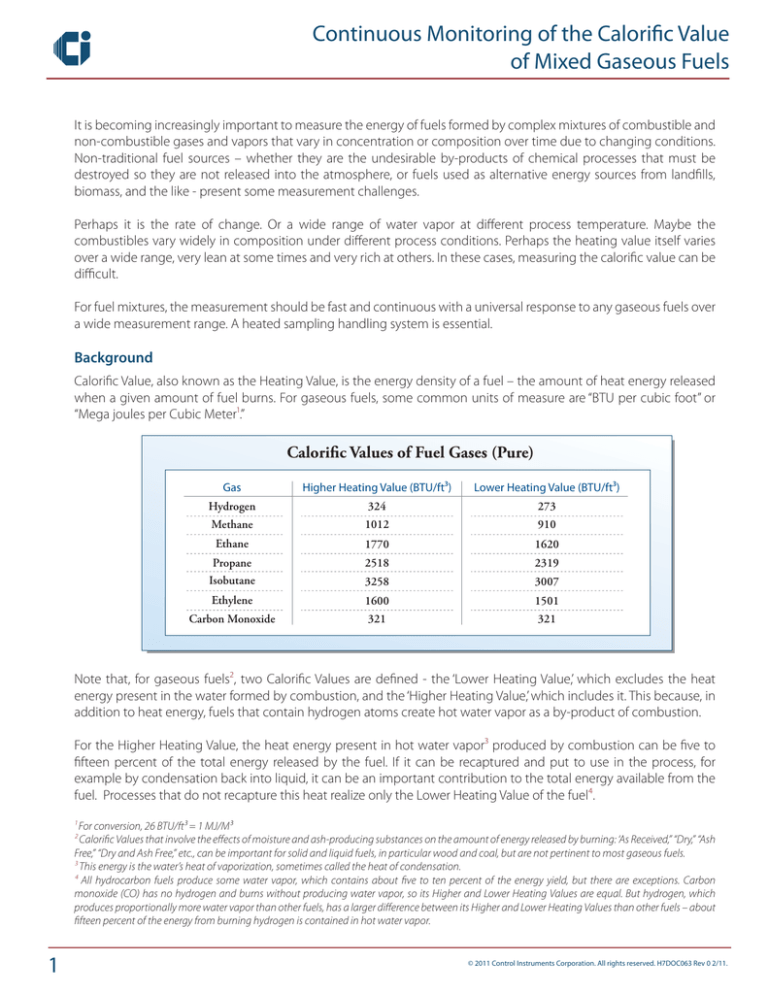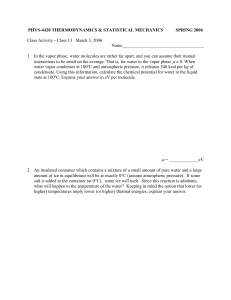
Continuous Monitoring of the Calorific Value
of Mixed Gaseous Fuels
It is becoming increasingly important to measure the energy of fuels formed by complex mixtures of combustible and
non-combustible gases and vapors that vary in concentration or composition over time due to changing conditions.
Non-traditional fuel sources – whether they are the undesirable by-products of chemical processes that must be
destroyed so they are not released into the atmosphere, or fuels used as alternative energy sources from landfills,
biomass, and the like - present some measurement challenges.
Perhaps it is the rate of change. Or a wide range of water vapor at different process temperature. Maybe the
combustibles vary widely in composition under different process conditions. Perhaps the heating value itself varies
over a wide range, very lean at some times and very rich at others. In these cases, measuring the calorific value can be
difficult.
For fuel mixtures, the measurement should be fast and continuous with a universal response to any gaseous fuels over
a wide measurement range. A heated sampling handling system is essential.
Background
Calorific Value, also known as the Heating Value, is the energy density of a fuel – the amount of heat energy released
when a given amount of fuel burns. For gaseous fuels, some common units of measure are “BTU per cubic foot” or
“Mega joules per Cubic Meter¹.”
Calorific Values of Fuel Gases (Pure)
Gas
Higher Heating Value (BTU/ft³)
Lower Heating Value (BTU/ft³)
Hydrogen
324
273
Methane
1012
910
Ethane
1770
1620
Propane
Isobutane
2518
2319
3258
3007
1600
321
1501
321
Ethylene
Carbon Monoxide
Note that, for gaseous fuels², two Calorific Values are defined - the ‘Lower Heating Value,’ which excludes the heat
energy present in the water formed by combustion, and the ‘Higher Heating Value,’ which includes it. This because, in
addition to heat energy, fuels that contain hydrogen atoms create hot water vapor as a by-product of combustion.
For the Higher Heating Value, the heat energy present in hot water vapor³ produced by combustion can be five to
fifteen percent of the total energy released by the fuel. If it can be recaptured and put to use in the process, for
example by condensation back into liquid, it can be an important contribution to the total energy available from the
fuel. Processes that do not recapture this heat realize only the Lower Heating Value of the fuel⁴.
¹ For conversion, 26 BTU/ft³ = 1 MJ/M³
² Calorific Values that involve the effects of moisture and ash-producing substances on the amount of energy released by burning: ‘As Received,” “Dry,” “Ash
Free,” “Dry and Ash Free,” etc., can be important for solid and liquid fuels, in particular wood and coal, but are not pertinent to most gaseous fuels.
³ This energy is the water’s heat of vaporization, sometimes called the heat of condensation.
⁴ All hydrocarbon fuels produce some water vapor, which contains about five to ten percent of the energy yield, but there are exceptions. Carbon
monoxide (CO) has no hydrogen and burns without producing water vapor, so its Higher and Lower Heating Values are equal. But hydrogen, which
produces proportionally more water vapor than other fuels, has a larger difference between its Higher and Lower Heating Values than other fuels – about
fifteen percent of the energy from burning hydrogen is contained in hot water vapor.
1
© 2011 Control Instruments Corporation. All rights reserved. H7DOC063 Rev 0 2/11.
Continuous Monitoring of the Calorific Value
of Mixed Gaseous Fuels
In non-conventional fuels, significant, varying, amounts of water vapor might also be present in a gaseous fuel mixture
before it is burned. This may mean that a wet basis measurement should be made, in which a sample of the fuel is
analyzed without removing any water vapor through condensation from temperature or pressure changes.
Otherwise, the loss of water vapor erroneously increases the concentrations of the remaining gases in the mixture
before reaching the analyzer, producing a large error⁵.
At atmospheric pressure, saturated water vapor can constitute up to 20% of the mixture’s volume at 60ºC (140ºF), but
only 2% at 20ºC (68ºF). If a sample saturated with water vapor is taken at 60ºC and is allowed to cool to 20ºC prior to
measurement, 18% of the sample volume turns to liquid. When the remaining gases are measured at 20ºC, the
concentrations are 22% higher in the partially dried sample, than in the true 60ºC mixture. Measurements taken on
partially dried samples have large errors.
Temperature Effects on Process Readings
HEATED SAMPLING SYSTEM
120˚C
20% Water Vapor
PROCESS
CONDITIONS
80% Combustible Gas No Condensate
60˚C
OR
20% Water Vapor
80% Combustible Gas
UNHEATED SAMPLING SYSTEM
20˚C
2% Water Vapor
98% Combustible Gas Plus Condensate
Keeping all parts of the sampling system and analyzer at 250ºF (120ºC) prevents this error under most conditions. Also,
a heated analyzer prevents condensation of heavier, less volatile hydrocarbons. Keeping all sample-wetted parts of the
sampling system and analyzer at a high temperature will ensure that these combustible vapors are properly measured.
A related effect occurs in a sample pump system. Even without a drop in temperature, the pump’s pressure rise lowers
the dew point and condenses out water, unintentionally increasing the concentration of the remaining gases. For a
60ºC mixture saturated with water vapor at atmospheric pressure, a +15 PSIG pressure rise condenses half of its water
volume. The concentrations of the remaining gases increase, causing an error of about 10%.
⁵ It is possible, but not preferable or practical, to recover and measure the removed water vapor to correct for dry basis measurement error.
2
© 2011 Control Instruments Corporation. All rights reserved. H7DOC063 Rev 2/11.
Continuous Monitoring of the Calorific Value
of Mixed Gaseous Fuels
Pressure Effects on Process Readings
ASPIRATED SAMPLING SYSTEM
120˚C
-0.5 PSIG
20% Water Vapor
PROCESS
CONDITIONS
80% Combustible Gas
60˚C
OR
0 PSIG
PUMPED SAMPLING SYSTEM
20% Water Vapor
60˚C
14.7 PSIG
10% Water Vapor
80% Combustible Gas
90% Combustible Gas Plus Condensate
Since many fuel mixtures contains a variety of combustibles gases and vapors along with nitrogen, carbon dioxide,
water vapor, etc., it is important to consider the response of the analyzer to each component. An analyzer’s response
to a particular gas relative to a standard reference gas is known as the response factor. The response often varies. A
calibration procedure can be used to correct the reading for a single gas, or a specific mixture, but is not practical for
mixtures which change composition or are not well known. In an ideal analyzer, all response factors should be
identical. In practice, no analyzer is ideal, but it is possible to have response factors close enough to minimize errors.
Because it actually burns a sample to determine the calorific value, a micro combustion calorimeter is a direct
measurement, and therefore has good response factors.
Gas
Gas
Higher Heating Value
(BTU/ft³)
Hydrogen
324
Micro Combustion Calorimeter Response
Factor (Relative to Methane)
1.18
Methane
1012
1.00
Ethane
1770
1.03
Propane
Isobutane
2518
1.08
3258
1.05
1600
321
1.02
1.03
Ethylene
Carbon Monoxide
3
Factor
© 2011 Control Instruments Corporation. All rights reserved. H7DOC063 Rev 2/11.
Continuous Monitoring of the Calorific Value
of Mixed Gaseous Fuels
In addition an analyzer should have a fast response time so it can quickly respond and activate controls for the
optimization of gas-blending. Applications include flare stacks, bio-fuels, turbine engines, and feed-forward control.
The performance and measurement range of a combustion calorimeter can be greatly improved by adding a known,
controlled amount of hydrogen to the sample stream prior to combustion. This stabilizes the flame and keeps the
measurement accurate over a wide range of calorific values. The flame can be kept lit and measuring accurately even
when the calorific value is zero.
By necessity, the flame in a hydrogen-fueled combustion calorimeter is small, and the hydrogen fuel requirement low.
Careful control and compensation for fuel and sample flow allows a precise measurement from a small flame size in
an apparatus that is small enough to be thermostatically heated to a high temperature. The small flame responds
quickly to changes in concentration, by using temperature detectors with low thermal mass. This analyzer has the
characteristics needed to quickly and continuously measure the heating value of a variety of combustible gases over
a wide range of measurement.
Summary
Some key points to consider when designing a system for continuous monitoring of the calorific value of mixed
gaseous fuels:
Heating prevents errors from condensation of water vapor. The sample stays intact during measurement.
Heating allows combustible gases with low vapor pressure (high boiling points) to be measured without losses
in the sampling system. False low readings are avoided.
The aspirated system does not increase pressure above the process conditions, preventing condensation of
water vapor or combustible gas that would otherwise condense. The sample is not affected.
Combustion calorimeter has good response factors, especially useful for unknown mixtures, practically “anything
that burns.”
The use of hydrogen fuel stabilizes the flame and widens the measurement range, including zero. The flame is
always ready to measure.
Its speed provides a continuous measurement that is useful when process conditions can change quickly. Speed
can be as important as accuracy. Often, speed is crucial.
4
© 2011 Control Instruments Corporation. All rights reserved. H7DOC063 Rev 0 2/11.





